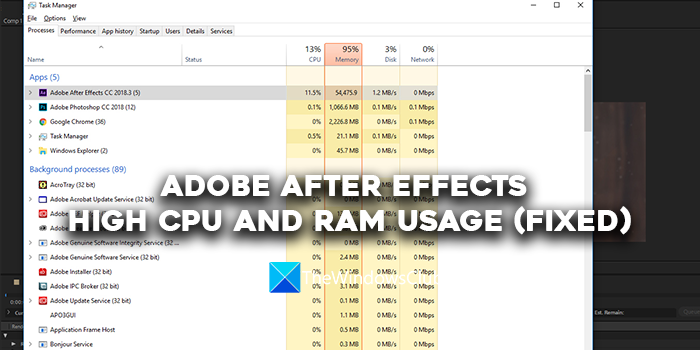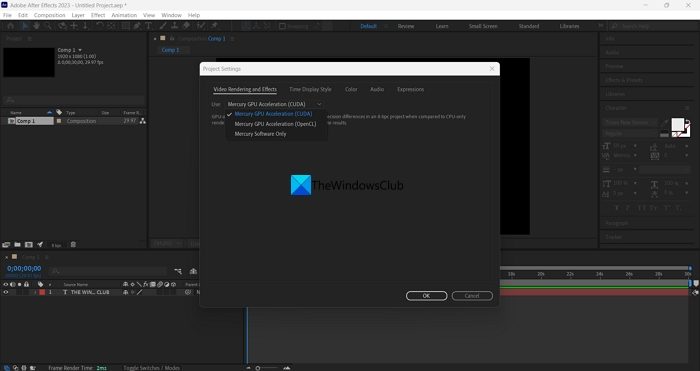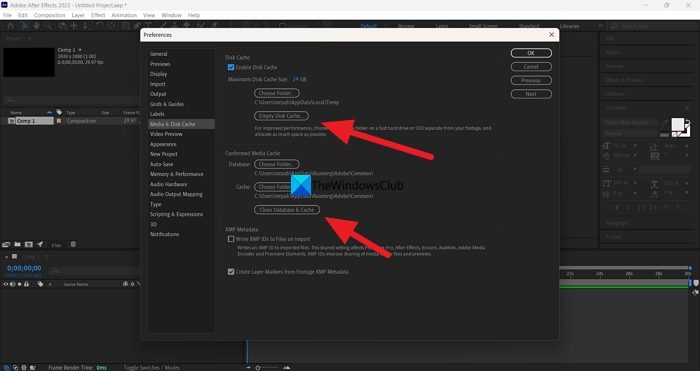Adobe After Effects is one of the best programs available to add effects and make visual effects-related additions to videos. You can use After Effects to even title the videos you make and animations. Though it is a paid software program, it is being used by millions around the world. However, some users see high CPU and RAM usage while using After Effects. In this guide, we show you how to fix Adobe After Effects high CPU and RAM usage.

Adobe After Effects high CPU and RAM usage (Fixed)
If you see high CPU and RAM usage by Adobe After Effects, you can follow the below methods to fix the issue.
- Make sure your system meets the minimum system requirements
- Close Google Chrome
- Adjust Playback quality
- Enable GPU acceleration
- Empty All memory and disk cache
- Enable hardware-accelerated Composition preferences
- Update After Effects
Let’s get into the details of each method.
1] Make sure your system meets the minimum system requirements
To run Adobe After Effects on your PC, your PC needs to meet minimum system requirements. Only, then the program will stop consuming more resources making it hard for other programs to run. If your PC does not meet the minimum system requirements, you need to upgrade your PC if you want to work on Adobe After Effects.
The minimum and recommended system requirements of Adobe After Effects are:
|
Minimum specifications |
Recommended specifications |
|
|
Processor |
Intel or AMD Quad-Core Processor |
(8-Core or above for Multi-Frame Rendering recommended) |
|
Operating system |
Microsoft Windows 10 (64-bit) V20H2 or later |
Microsoft Windows 10 (64-bit) V20H2 or later |
|
RAM |
16 GB of RAM |
32 GB recommended |
|
GPU |
2 GB of GPU VRAM Note: For systems with NVIDIA GPUs, Windows 11 requires NVIDIA driver version 472.12 or later. |
4GB or more of GPU VRAM recommended |
|
Hard disk space |
15GB of available hard-disk space; additional free space required during installation (cannot install on removable flash storage devices) |
Additional disk space for disk cache (64GB+ recommended) |
|
Monitor resolution |
1920 x 1080 |
1920×1080 or greater display resolution |
2] Close Google Chrome
It is a well-known fact that Google Chrome consumes more resources on your PC. While you are working on Adobe After effects, it is recommended to stop using Google Chrome. This way Adobe After Effects would not have to fight for more resources to run smoothly.
3] Adjust Playback quality

If you are using a normal PC that is not built for editing or running heavy programs like Adobe After Effects, you will see high CPU and RAM usage by After Effects as it needs to encode and decode videos in the quality you have selected. You need to adjust the playback quality using the drop-down button you find below the preview of your timeline. Click on the drop-down button and select Half of 1/4 from the options and see if it has made any difference.
4] Enable GPU acceleration

If you have not enabled GPU acceleration in the Project Settings of Adobe After Effects, you may see high CPU usage acceleration as the project and its tasks are using the resources of your CPU to perform various functions. You need to enable GPU acceleration using the File menu. Go to Project settings in the File menu. Then, click on the drop-down button under Video Rendering and Effects tab. Then, select Mercury Playback Engine GPU Acceleration (CUDA) if you are using an NVIDIA graphics card, or select Mercury Playback Engine GPU Acceleration (OpenCL) if you are using an AMD graphics card. Click OK to save changes.
5] Empty All memory and disk cache

The memory and disk cache that build up over the usage of Adobe After Effects might be causing the high CPU and RAM usage on your PC. To fix that you need to empty all memory and disk cache. To do that, click on Edit in the Menu bar and select Preferences. Select Media & Disk Cache tab. Then, click on Empty Disk Cache under Disk Cache and click on Clean Database and Cache under Conformed Media Cache. It will clear all media and disk cache. Then, click OK to save changes.
Read: Adobe Media encoder not installed in Premiere Pro
6] Enable hardware-accelerated Composition preferences

Whenever you work on After Effects, the encoding and decoding of the compositions are done by software components of Adobe using various codecs. You need to change it to hardware-accelerated encoding and decoding by enabling it. Once you enable it, whatever project you work, it will all be encoded and decoded using hardware acceleration. To do that, click on Edit in the menu, select Preferences, and Display. Then, check the box beside Hardware Accelerate Composition, Layer, and Footage Panels. Then, click OK to save changes and restart After Effects. If it is enabled already, disable it and see if it changes anything.
7] Update After Effects
If none of the above methods fix the high CPU and RAM usage of Adobe After Effects, you need to update After Effects to the latest version. The issue might have been caused by corrupted or missing files from Adobe After Effects. It might also have been caused by bugs in the previous update. You need to update it to the latest version using Adobe Creative Cloud to fix the issue.
Read: Difference between Adobe Premiere Pro and Adobe After Effects
These are the different ways to fix the high CPU and RAM usage of Adobe After Effects on Windows 11/10.
Does After Effects use RAM or CPU?
Yes, Adobe After Effects uses RAM and CPU to run its components and make your work on it seamless. You need to have a system that can meet or exceed the minimum system requirements of Adobe After Effects. If not, After Effects will work very slowly or consume more resources on your PC.
How much RAM do I need to run Adobe After Effects?
The recommended RAM you need to run Adobe After Effects is 32 GB. You need to have at least 16 GB of RAM to run After Effects on your PC. If not, After Effects will not work as desired and make it hard for you to work on your compositions and projects.
Related read: Fix Adobe Premiere Pro high CPU usage.